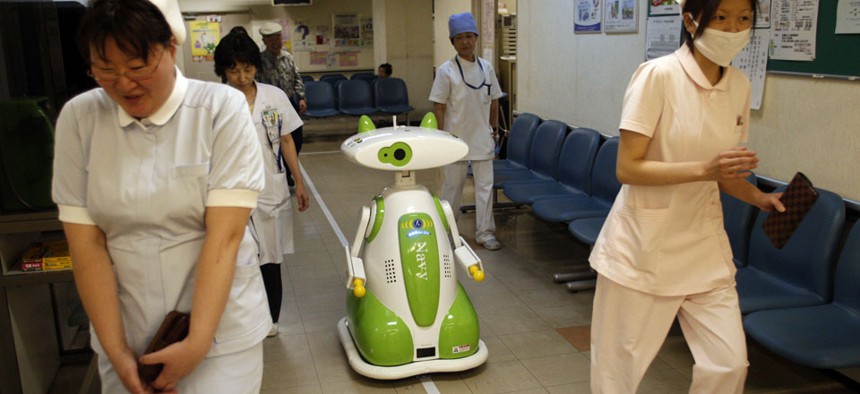Most of What Your Doctor Does, a Robot Can Do Better

David Guttenfelder/AP File Photo
When it comes to certain tasks, many machines have become stand-ins for physicians.
In Her, Spike Jonze’s Oscar-winning romance between a man and his operating system, we are pushed to reevaluate our relationships with computers. If it could listen and respond intelligently to your every concern, would you prefer dating a computer over a distracted, self-involved human? But for me, it’s not in my love life that I feel most replaceable. It’s in my choice of profession—medicine.
It started innocently enough. Robots like the DaVinci surgical system behaved as tools, needing the hands of their masters to function. Then some advanced past mechanical labor to read and write, and became a little less deferent. Electronic health records stop doctors if we prescribe the wrong medications or if we forget to ask the right questions at an annual checkup.
Now machines have become stand-ins. Virtual avatars called “relational agents” handle daily conversations to motivate weight loss and “watch” while patients take their medications. And their diagnostic skills are improving: In January 2013, a group from Indiana University achieved 41.9% better diagnostic accuracy with their artificial intelligence algorithm than trained physicians. Four years of medical school and five-plus years of residency later, we’ve got nothing on Her.
The irony is that as machines gain an edge in these domains, we doctors in training lose our edge in the domains that are left. My generation of physicians doesn’t know how to physically examine patients. It’s not surprising, given that as hospital interns we spend less than 8 minutes at the patient’s bedside, by the computer all day instead.
There are non-robotic elements to medicine, for sure. Patients want a person with them through a tough diagnosis and when they weigh treatment options. But doctors don’t take the time to do these things anymore. If anyone does, it’s nurses.
My medical education focuses on recognizing pathologies under tight deadlines: efficiency and specialized pattern recognition. I’m hard pressed to make a case for my edge over a robot in these domains. And if I have no edge, I would be doing my patients a disservice to guard my job.
Doctors average 23 seconds before interrupting their patients. Why tolerate that disrespect when a machine could process the same information politely and produce the right diagnosis more often? With competition like this, the division of labor in medicine between man and machine is going to change. The next phase may follow the chess world.
After the Deep Blue supercomputer beat the world champion Garry Kasparov in 1997, something interesting happened. Humans didn’t stop playing chess. Instead, “advanced chess” was born, whereby humans and computers teamed up. Some of those teams won against the otherwise unbeatable supercomputers.
In medicine too, doctors hold the potential for synergy with their programmed counterparts. It is worth noting that the best human-computer chess teams were not composed of the best independent chess players. Instead, it was the humans who asked a lot of questions and took the time to weigh the computer’s different approaches.
The best doctors will no longer be the ones with the best memory for differential lists or dosages, the doctors who were the most impressive against computers. Now that computers have eclipsed us in these realms, the best doctors will hone complementary skills with computers. They will focus on relating to their patients as people, and when planning treatment they will have the humility to leverage technical tools rather than try to do it all on their own.
As a patient, I wouldn’t want a robot to replace my doctor. But what’s the difference if we doctors behave robotically, anyway? As technology answers more of my medical questions, I want my doctor to focus on the ones that aren’t so mechanical: to take time to discuss end of life decisions, comfort me through cancer treatments, and to lay healing hands. Make me feel heard, and I won’t choose Her.
Reprinted with permission from Quartz. The original story can be found here.





